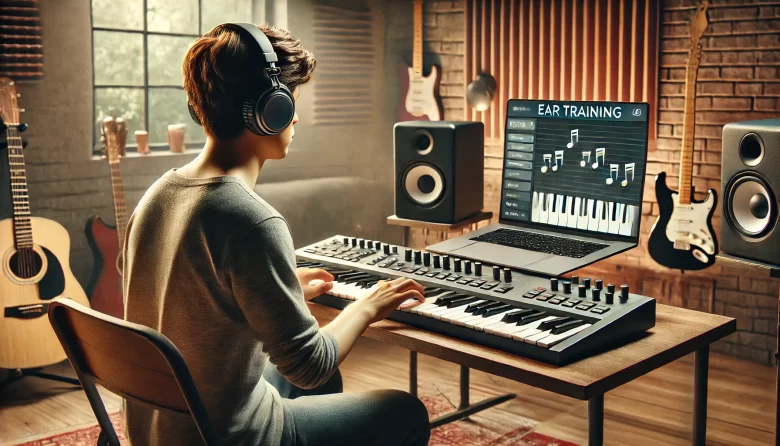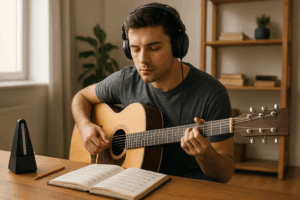When you hear musicians say they can “play by ear,” it might seem like a magical ability — but in reality, it’s a skill that anyone can learn with practice. Training your musical ear is one of the most rewarding parts of learning music. It strengthens your ability to recognize melodies, chords, intervals, and rhythms by sound alone. Even as a complete beginner, you can start developing your ear from day one.
This article will guide you through what ear training is, why it’s important, and the best beginner-friendly exercises to start building this powerful skill.
What Is Ear Training?
Ear training is the process of improving your ability to identify and understand musical elements purely by listening. This includes:
- Recognizing pitches and notes
- Identifying intervals between notes
- Hearing chord types and progressions
- Distinguishing rhythms and time signatures
- Transcribing music by ear
While it might sound complex, ear training starts with simple, repeatable exercises that gradually improve your listening skills.
Why Ear Training Matters for Beginners
1. Helps You Play Songs by Ear
With a trained ear, you can figure out songs without needing sheet music or tutorials — just by listening and playing what you hear.
2. Improves Your Memory
When you train your ear, you improve your musical memory. You’ll remember songs, patterns, and progressions more easily.
3. Makes You a Better Musician Overall
You’ll develop better pitch accuracy, timing, and the ability to improvise or compose music more naturally.
4. Enhances Communication with Other Musicians
You’ll be able to recognize and respond to musical cues during rehearsals or jam sessions, even without a written score.
5. Builds Confidence
With a stronger ear, you can trust yourself more when playing, singing, or even learning a new instrument.
Beginner-Friendly Ear Training Techniques
You don’t need expensive equipment or formal training to develop your ear. These simple exercises can be done at home, at your own pace.
1. Start with Pitch Matching
- How it works: Play a note on your instrument or a keyboard app, and try to sing or hum the same note.
- Why it helps: This builds pitch awareness and helps you match what you hear to your voice or instrument.
Tip: Use a piano app or digital tuner to check if you’re hitting the right pitch.
2. Learn to Recognize Intervals
An interval is the distance between two notes. Start by learning the sound of simple intervals:
- Unison – Same note
- Major 2nd – Like the start of “Happy Birthday”
- Perfect 4th – Like the beginning of “Here Comes the Bride”
- Perfect 5th – Like the opening of the Star Wars theme
There are many free apps (like Tenuto, Perfect Ear, or Musictheory.net) that help you identify and practice intervals.
3. Sing Scales
Singing helps connect your voice to your ear. Start with the major scale:
Do – Re – Mi – Fa – Sol – La – Ti – Do
Try to sing it up and down, and then skip notes (e.g., Do – Mi – Sol – Do) to build internal pitch recognition.
4. Practice Call and Response
Have a friend or app play a short melody, and try to sing or play it back. Start with just 3 or 4 notes and increase difficulty over time.
5. Try Active Listening
Next time you listen to a song, pay close attention to the musical structure. Ask yourself:
- What instrument is playing the melody?
- Can I hear the bass line?
- What’s the chord progression?
- Can I clap along to the rhythm?
This builds musical awareness and helps your brain make connections.
6. Transcribe Simple Melodies by Ear
Pick a short melody you know well (like “Twinkle, Twinkle Little Star”) and try to play it on your instrument without using sheet music. If you get stuck, slow it down or hum the melody until you figure it out.
7. Use Online Tools and Apps
Some great tools for beginners include:
- TonedEar – Interval and chord recognition exercises
- Functional Ear Trainer – Focuses on hearing notes in a key
- EarMaster – Comprehensive app with guided lessons
- YouTube Ear Training Channels – Many free resources available
Start with 5–10 minutes a day and increase as you improve.
Tips to Make Ear Training Stick
- Be consistent – A few minutes every day is better than one long session a week.
- Stay patient – Just like learning an instrument, ear training takes time and repetition.
- Sing often – Your voice is one of the best tools for connecting sound and pitch.
- Test yourself regularly – Try identifying intervals, chords, or notes in songs you listen to.
- Keep it fun – Mix games, songs, and improvisation to keep things engaging.
How Long Does It Take to Train Your Ear?
There’s no fixed timeline. Some people notice improvements in weeks, others take a few months. The key is daily practice, even if it’s just for a few minutes. With time, you’ll start to “hear” music in a whole new way — recognizing patterns, notes, and rhythms naturally.
Final Thoughts: Your Ears Are Your Best Musical Tool
When it comes to learning music, your ears are just as important as your fingers or voice. The earlier you start training them, the faster you’ll grow as a musician. Don’t worry about being perfect — just aim to be a little better today than you were yesterday.
Remember: great musicians aren’t born with perfect ears — they develop them. And you can too.




